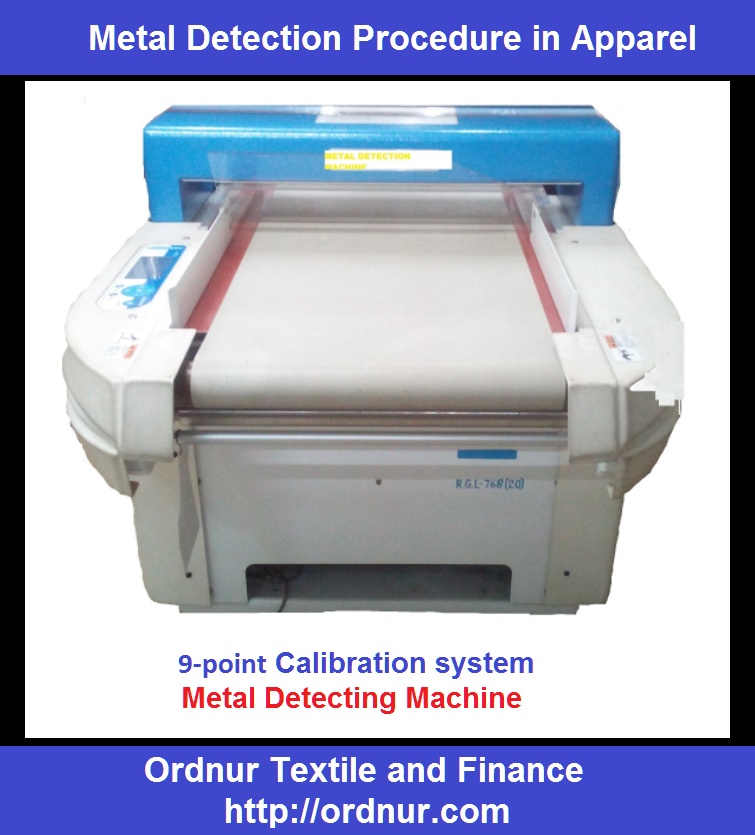Metal Detection is the final precautionary measure used to get needle/metal-free final product. It is not a replacement for well-maintained needle control procedures. Metal Detection Procedure in Apparel could be the final needle detection system and machine calibration (whether a machine is functioning properly or not) is checked by a 9-point calibration system. The metal detection machine should be located in the packing section to ensure that after the metal detection process, garments will remain inside a metal/needle free zone. Machine calibrated with a 9-point method or any other suggested method given by the supplier/buyer. This process should continue for every hour & keep the record.
Objectives of Metal Detection in Garments
The final product of garments should be metal or needle-free, otherwise, it can harm the user of garments. Here are the few objectives of metal detection:
- To get a needle-free final product
- To get a metal-free final product in carton
- Secure product safety
- Metal detection is mandatory for all children to wear garments, and this also varies according to the buyer wise requirement.
- To meet customer satisfaction
Metal Detection Procedure in Apparel
Metal Detection Procedure of Garments Manufacturing are explained below
- All goods must be passed through the Metal Detector except in exceptional circumstances where the nature of the product dictates that this cannot be done. This must be agreed with the buyer beforehand; and signed on the Operation Manual or Product Specification (I.e. (a) Certain accessories, (b) PRO, where the stitched upper is passed through the detector Goods with ferrous metal components.
- All goods must be passed through a Metal Detector set to the standard of a 1.2 mm sphere. As the majority of the trims and decorations are non-ferrous, it is a requirement that a ferrous metal detector is used.
- Records and samples must be kept of any contamination detected, starting date, and time, product type, and the cause of resultant actions to be kept in a secure location.
- When a metal is detected, only supervisors or managers can reactivate the equipment. It is therefore mandatory that a Security Key Switch is used to ensure this.
- The x-ray machine is needed where tacks are used in production (i.e. handsewn shoes, moccasins, etc.)
Metal Detector Machine Calibration by 9 Point System
9-point testing of metal detector refers below points
- Calibrate (Test) machine 3 times each day in the beginning, middle, and end of a working period by using the 1.2mm sphere ferrous checks cards to check machine sensitivity.
- Test at 9 points at every time
- Test from the top, Centre, and bottom position in the left, middle, and right side of the machine, total of 9 points.
- If any point not detected by the machine should recheck the point again.
Description of Machine Calibration Check
Machine Calibration check purpose to check machine sensitivity. The sensitivity should be set by passing the test sample through/at the (i) Centre (ii) Left Side (iii) Right Side of the detector. This process will be repeated by placing the test sample at a raised height, allowing the test sample to pass through the middle of the detector. The 1.2mm test sample must be kept available at all times. The detector must be tested with the 1.2mm test sample a minimum of 3 times per working session, which is defined as a shift. The test should be carried out prior to starting detection, at an intermediate point, and at the end of the session using the test sample. A record should be kept of the time and date by the supervisor. When a detector fails to detect the test sample, all merchandise that has passed through the detector since the last correctly completed test must be rechecked through the metal detector. It is good practice to be able to identify each batch of production that has passed through the detector since the last test.
- The Metal detector is positioned such that goods need to pass through the metal detector in order to be shipped out (finishing to packing or packing to the warehouse).
- The best practice is to have a magnetized station/ table where the tacks are removed; when the operator holds the lasted upper on this and pulls the tacks out, they are pulled and held in place until the operator removes them to a dedicated sharps storage container. An alternative solution is to use a magnetic /generator coils (about 12 to 15 inches in diameter) as cradles during the de-tacking process.
- Machines must be serviced, certified, and calibrated by the Metal Detection Company or recognized 3rd party testing company.
- Records are to be kept.
Metal Detection Procedure in Apparel also Refer to-
- Needle detection procedure in Garments
- 9 Points calibration system
- Product safety in Garments
Download: Needle Detection Report Format (Excel 47kb)




What is the strength of Metal detector machine? I heard this question from an interview and I could not answer about this question. Please help me by answer this question.
What is the strength of Metal detector machine?
what is cooling hour in metal detection of garments
Thanks for the information. And how to maintain the needle detector? Hope to know more about it